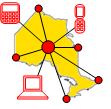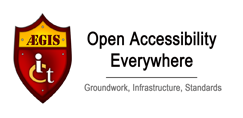News and Events
The AEGIS-Ontario project is proud to welcome Komodo OpenLab (http://komodoopenlab.com/) as its newest private sector research partner. Komodo had already been working for some time to commercialize the Tecla Access for Android system (http://mobile-accessibility.idrc.ocad.ca/projects/tekla), an AEGIS-Ontario research project.
Oct 22, 2012 - New version of Tecla Access for Android app is released
We've just released a new update for the Tecla Access for Android app that is available on the Google Play Store.
On Sept. 26, the GNOME Project celebrated the release of GNOME 3.6, the latest version of the popular free desktop, which also included the AEGIS(Ontario) project's work on built-in magnification, mouse cross-hairs, lightness inversion, contrast and brightness.
http://library.gnome.org/misc/release-notes/3.6/a11y-magnifier-bightness-contrast-inversion.html.en
Sep 27, 2012 - AEGIS(Europe) videos present outcomes
Our AEGIS(Europe) partners have produced two videos presenting some of the accessibility innovations that have come out of the work we have done together. The first video is here: http://www.youtube.com/watch?feature=player_embedded&v=X8miIhqQ3MU#!
Jul 13, 2012 - AEGIS Featured in New Videos
The IDRC and AEGIS Project deliverables, in particular were recently featured in two videos produced by the Ontario Premier's office:
http://www.youtube.com/watch?v=AIBzFT_sd94&feature=relmfu
http://www.youtube.com/watch?v=ayyGiGweEWA&feature=relmfu
May 7, 2012 - BlackBerry Screen Reader Announced!
RIM, a private-sector partner in the AEGIS(Ontario) and AEGIS(Europe) projects has announced the release of a FREE screen reader for the BlackBerry Curve.
Apr 10, 2012 - ATAG 2.0 Last Call
The Authoring Tool Accessibility Guidelines Working Group has published an updated Last Call Working Draft of Authoring Tool Accessibility Guidelines (ATAG) 2.0 (http://www.w3.org/TR/ATAG20/) and a Working Draft of Implementing ATAG 2.0 (http://www.w3.org/TR/2012/WD-IMPLEMENTING-ATAG20-20120410/). ATAG defines how authoring tools should help developers produce accessible web content that conforms to Web Content Accessibility Guidelines (WCAG) 2.0. It also defines how to make authoring tools accessible so that people with disabilities can use them.
Mar 29, 2012 - GNOME 3.4 gets Zoom Options
The newly released GNOME 3.4 includes new options for configuring the zoom feature. These options are part of the GNOME Shell Magnifier that the IDRC has been developing as part of the AEGIS(Ontario) project. The new zoom options allow you to change the magnification factor, the mouse tracking, the position of the magnified view on the screen and enable crosshairs to be added to help you find the mouse or touchpad pointer. For more information, visit: http://library.gnome.org/misc/release-notes/3.4/#rna11y.zoom-settings
Mar 7, 2012 - Switch Access to iPhone/iPad Coming Soon!
The IDRC and Komodo OpenLab has been exploring how the Tecla shield can be used to provide full switch access solution to iOS devices. A sneak peak is available here: http://www.youtube.com/watch?v=Q5ommI5pEv4
An update of the Tecla keyboard for Android is available. The keyboard supports ability switch users with scanning, but is also an excellent accessibility testing feature for Android developers because its Navigation keyboard mimics the D-pad for devices without physical keyboards. Check it out at: https://market.android.com/details?id=ca.idi.tekla&hl=en
Dec 19, 2011 - Tecla at a Google TechTalk
Jorge Silva presented Tecla at a Google TechTalk (http://www.youtube.com/watch?v=iZFmindk-Tg)
Oct 14, 2011 - Fluid Infusion v1.4 Released
Infusion 1.4 is a major new release of Fluid's JavaScript application framework. This version includes improved user experience for Uploader, Completely redesigned UI Options component, many improvements to the Fluid Skinning system, substantial improvements to the Infusion IoC system, and updated versions of jQuery and jQuery UI.
Aug 19, 2011 - Article about ATAG 2.0
CMSwire.com has published an article that highlights ATAG 2.0 and UAAG 2.0 entitled "W3C Project Targets Accessible Web Content Authoring Tools".
Aug 17, 2011 - Accessiblity Design Contest for Ontario Students!
The Stretch 2.0 Accessible Design Contest is a chance to stretch the boundaries of exclusion - by working on art or computing projects that include everyone, regardless of ability or disability!
Jul 21, 2011 - New ATAG 2.0 Public Working Draft Call for Review
W3C WAI is inviting review of the updated Working Drafts of Authoring Tool Accessibility Guidelines (ATAG) 2.0 published on 21 July 2011 (see http://www.w3.org/TR/ATAG20/).
Jun 17, 2011 - jQuery Accessibility Hackathon
The IDRC is hosting a jQuery Accessibility Hackathon from July 11-12, 2011 (with three additional optional days from July 13-15).
Apr 27, 2011 - New ATAG 2.0 Public Working Draft Call for Review
W3C WAI is inviting review of the updated Working Drafts of Authoring Tool Accessibility Guidelines (ATAG) 2.0 published on 21 April 2011 (see http://www.w3.org/TR/ATAG20/).
Feb 11, 2011 - Print me a Stradivarius (or a better case for my mobile)
In a signal that rapid prototyping is beginning to reach the mainstream, The Economist magazine has published an article on rapid prototyping entitlled: Print me a Stradivarius
How a new manufacturing technology will change the world (http://www.economist.com/node/18114327).
OCAD University is launching an innovative new graduate program in Inclusive Design. Inclusive Design is design that is inclusive of the full range of human diversity with respect to ability, language, culture, gender, age and other forms of human difference.
Jan 21, 2011 - ARIA 1.0 moves to Candidate Recommendation
ARIA 1.0, a W3C technical specification for making dynamic, interactive web content accessible to people with disabilities, has progressed to Candidate Recommendation status. This means that the W3C judges the specification to be stable enough to invite implementation. Through the AEGIS Project, the IDRC participates as both a developer and implementor of ARIA.
Jan 4, 2011 - Fluid Infusion v1.3 is released!
Infusion 1.3 is a major new release of Fluid's JavaScript application framework. This version includes substantial accessibility improvements, plugin-free HTML 5 support for the Uploader component, and variety of new framework features including the Inversion of Control system for creating highly adaptable and easy-to-test applications. This release is an incremental upgrade and preserves backwards API compatibility for all production-grade components.
Dec 8, 2010 - Freely Available ISO Standards
ISO has made a number of standards, including at least two related to accessibility freely available on their Publically Available Standards site.
Nov 30, 2010 - Tekla project featured in SparkFun's site
Sparkfun is an electronics prototyping vendor with an open-source business model, and since some of their parts were used to create the Tekla Shield, they thought it would be a good idea to feature our project on their site.
Nov 29, 2010 - ÆGIS work demonstrated at EC Review
The ÆGIS(Ontario) research work was on display in Brussels, Belgium on Nov. 23-24 at the annual EC Review of the ÆGIS(Europe) Project.
Oct 19, 2010 - Sip & Puff Switch user controls Android with Tekla
Eric Wan, demonstrates how he controls an Android handset using Tekla, an ÆGIS-supported app he helped develop.
Aug 30, 2010 - ÆGIS contributor featured in Canadian Press story
Eric Wan, one of the main contributors of the Tekla mobile on-screen keyboard has been featured in a Canadian Press story.
Jul 19, 2010 - Status of ARIA Implementation in Windows Browsers
This specification provides an ontology of roles, states, and properties that define accessible user interface elements.
Jul 16, 2010 - 1st AEGIS International Conference
The 1st AEGIS International Conference showcasing the world's most influential open source, web and mobile accessibility projects.
Feb 17, 2010 - Updated Results
The Results section of the website has been added. This section will host all of the ÆGIS (Ontario) deliverables (software, reports, links to web sites, etc.) as they become available.
May 13, 2009 - New Website
Welcome to our new website, and check back often while we get content posted.


